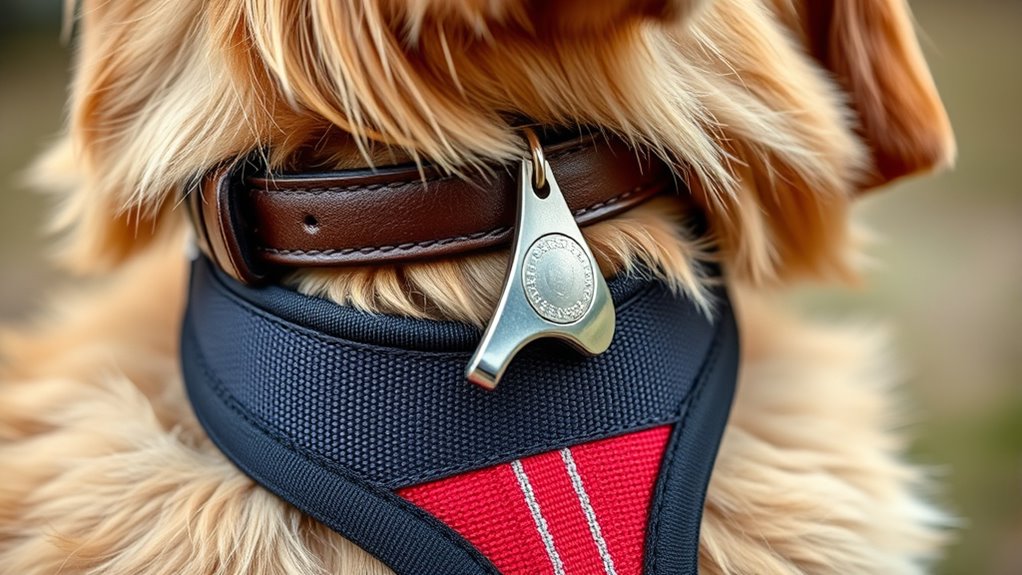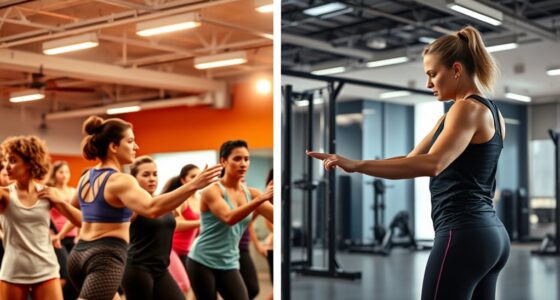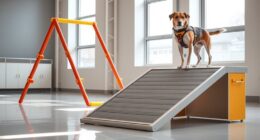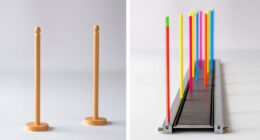Choosing the right dog training tools can make a big difference in your training success. Collars like martingales offer gentle control, while choke chains require caution. Harnesses come in different styles to suit your dog’s activity level, helping with pulling or comfort. Clickers are great for positive reinforcement, marking good behavior clearly. To guarantee safety and effectiveness, it’s vital to select tools suited for your dog’s breed and personality—continue to explore for more helpful tips.
Key Takeaways
- Different collars like martingale and choke chains serve specific training purposes and vary in comfort and control.
- Harness selection depends on material, fit, and dog behavior to improve control and reduce strain during walks.
- Clickers enhance training by providing clear, consistent signals that mark desired behaviors quickly and effectively.
- Safety tips include ensuring proper fit, avoiding harsh corrections, and regularly inspecting equipment for damage.
- Choosing the right training tools depends on your dog’s breed, size, activity level, and temperament for optimal results.
Understanding Different Types of Collars and Their Uses
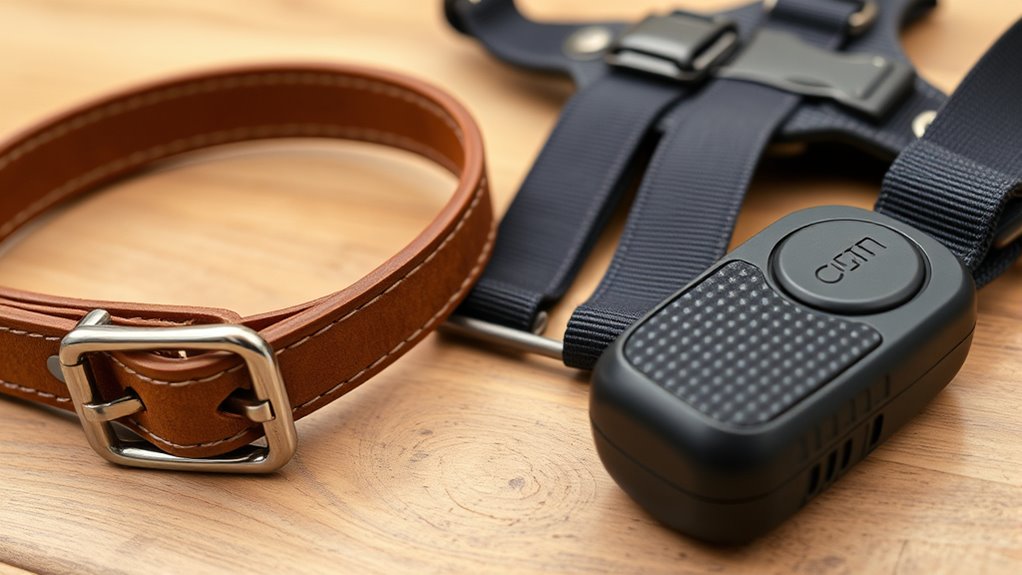
When choosing a collar for your dog, it’s important to understand the different types available and their specific purposes. Martingale collars are designed to provide gentle control without choking, making them ideal for dogs that tend to slip out of traditional collars. They tighten slightly when the dog pulls, giving you better control while remaining comfortable. Choke chains, on the other hand, are more traditional and can be effective for training certain behaviors, but they require careful use to avoid injury. Choke chains tighten around the neck when pulled, which can be harsh if misused. Both collars serve different training needs: martingale collars promote safety and control, while choke chains demand cautious handling. Understanding these differences helps you choose the right collar for your dog’s training and safety.
Choosing the Right Harness for Your Dog’s Needs
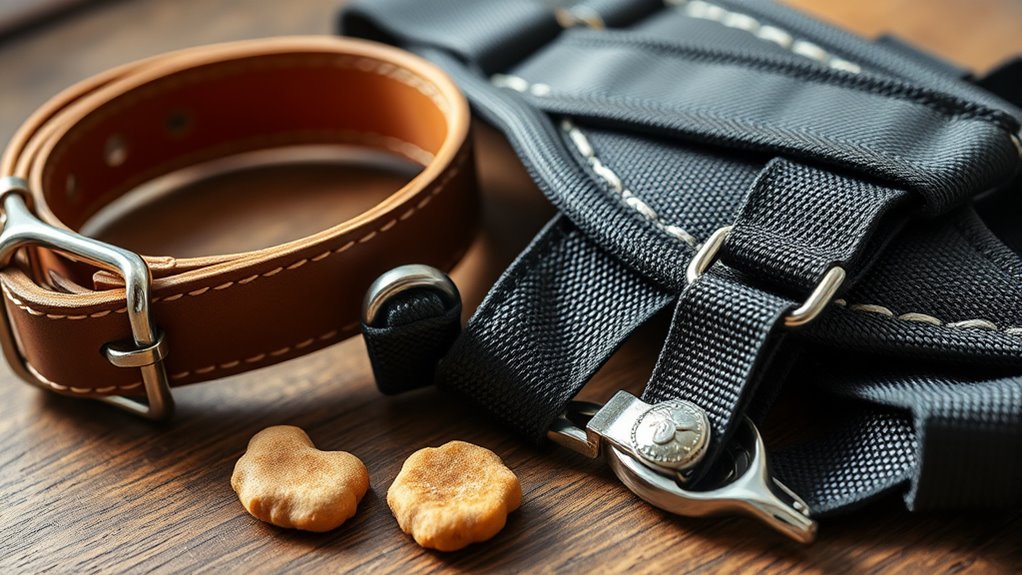
Choosing the right harness for your dog’s needs is essential for both safety and comfort during walks and training. Consider harness materials like nylon, leather, or padded options, which influence durability and comfort. For active dogs or those prone to pulling, a no-pull harness can improve control and reduce strain. If your training routines involve frequent walks or behavioral work, select a harness that offers a secure fit without restricting movement. Proper fit is vital—too tight can cause discomfort, while too loose may slip off. Think about your dog’s size, activity level, and specific training goals. The right harness supports effective training and keeps your dog comfortable, making every walk a more enjoyable experience for both of you. Additionally, understanding how creative practice can enhance your training approach may lead to more innovative and effective techniques. Incorporating positive reinforcement techniques into harness training can also improve your dog’s responsiveness and overall behavior. Being aware of training methods and selecting the appropriate tools ensures a harmonious training process, especially when considering the importance of vetted safety products for your pet’s well-being. Recognizing how self watering plant pots work can inspire innovative approaches to training routines that maintain consistency and patience.
How Clickers Enhance Training and Communication
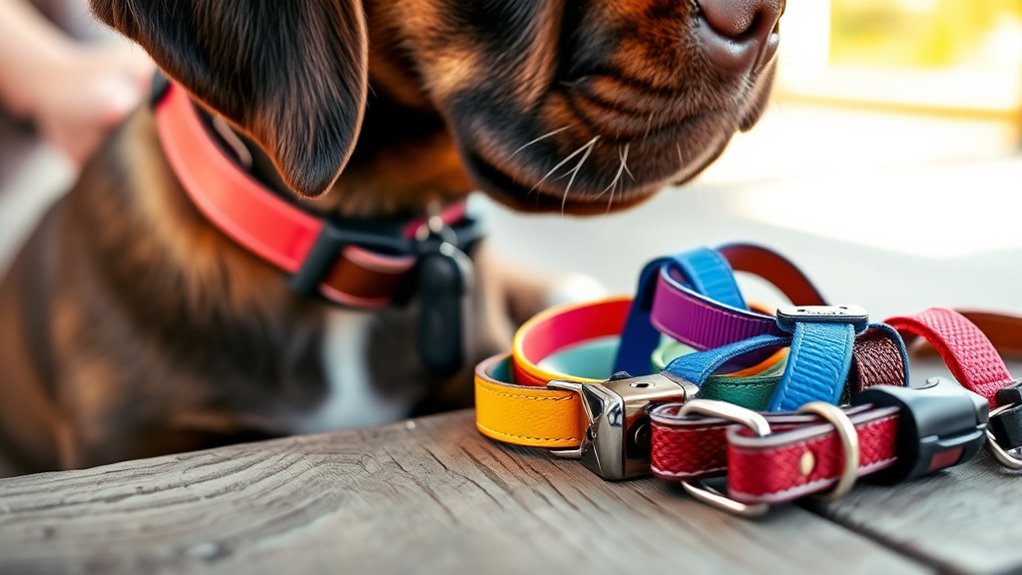
Using the right training tools can make a big difference in how effectively you communicate with your dog. Clickers are powerful for positive reinforcement, helping your dog associate a specific behavior with a clear, consistent signal. When used properly, clickers accelerate behavior shaping by marking exact moments of desired actions. This clarity boosts learning and builds trust between you and your dog. To visualize how clickers support training, consider this table:
| Benefit | How It Works | Result |
|---|---|---|
| Clear cues | Marks precise behavior | Faster learning |
| Consistency | Reinforces positive acts | Reliable responses |
| Motivation | Creates positive associations | Enthusiastic participation |
| Behavior shaping | Guides complex behaviors | Improved obedience |
Clickers make communication precise, effective, and enjoyable for both of you.
Safety Tips for Using Training Tools Effectively

Ensuring safety while using training tools is essential for both your dog’s well-being and effective training. Always prioritize positive reinforcement, rewarding good behavior to build trust and encourage learning. Regular equipment maintenance is crucial; inspect collars, harnesses, and clickers for signs of wear or damage before each session. Proper fit is vital—too tight can cause discomfort, while too loose reduces control. Use training tools as intended and avoid harsh corrections, which can cause stress or injury. Be attentive to your dog’s responses, adjusting your approach if you notice discomfort or hesitation. Clear, consistent signals combined with positive reinforcement create a safe environment for training. Additionally, understanding air quality can help ensure your training space remains healthy and free from pollutants that might affect your dog’s breathing or comfort. Maintaining good ventilation in your training area can also reduce the accumulation of dust or allergens that could impact your dog’s respiratory health. Being aware of environmental factors such as humidity and temperature further supports your dog’s safety during training. Regularly checking the equipment for wear and replacing damaged items prevents potential accidents and injuries. Moreover, incorporating appropriate training techniques that are gentle and respectful helps prevent stress and promotes a positive learning experience. Remember, safety and proper tool use foster a positive experience that benefits both you and your dog.
Selecting the Best Equipment Based on Your Dog’s Behavior
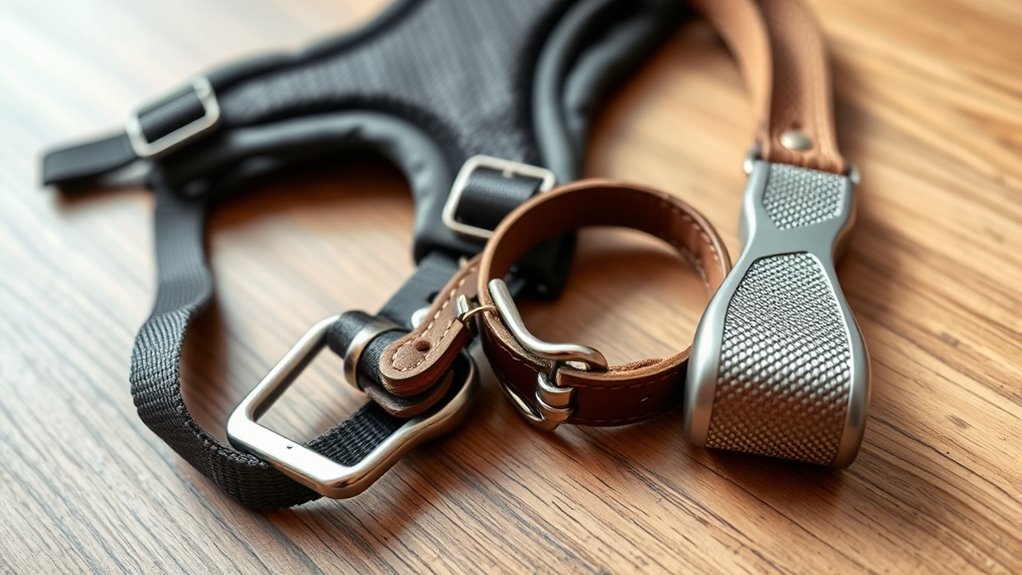
Understanding your dog’s behavior is key to selecting the most effective training equipment. Breed-specific training can influence your choice, as some breeds respond better to certain tools. For example, high-energy breeds may benefit from harnesses that provide control without discomfort, while smaller breeds might require gentler options. Leash attachment choices also matter; a front-clip harness encourages better behavior during walks, while a traditional collar might suit calmer dogs. Consider your dog’s temperament, size, and activity level when choosing equipment. Use this table to guide your decision:
| Behavior/Need | Recommended Equipment |
|---|---|
| Pulls on leash | Front-clip harness |
| Sensitive neck | Head collar or gentle collar |
| High energy, active dog | Durable harness with multiple attachment points |
| Breed-specific training | Breed-appropriate tools for comfort and control |
| Calm, well-behaved dog | Standard collar or light harness |
Being aware of the WWE Raw’s financial impact highlights the importance of choosing the right tools for your dog’s training to achieve successful results. Additionally, understanding the contrast ratio of your training tools can help ensure clear communication and effective training sessions. Recognizing the importance of holistic training methods can also enhance your dog’s overall well-being and responsiveness.
Furthermore, integrating dynamic communication exercises into your training routine can strengthen your bond and improve obedience. Incorporating electric-powered tools such as clickers and remote trainers can accelerate learning, especially when tailored to your dog’s specific needs.
Frequently Asked Questions
How Do I Introduce New Training Tools to My Dog Safely?
You want to introduce new training tools safely, so start with a positive reinforcement approach. Gradually introduce the tool by allowing your dog to sniff and explore it first. Use treats and praise to create a positive association. Keep initial sessions short and calm, watching for signs of discomfort. Slowly increase exposure while maintaining a gentle, patient attitude, ensuring your dog feels comfortable and confident with the new tool.
Can Training Tools Be Used for Aggressive or Fearful Dogs?
You can use training tools for aggressive or fearful dogs, but you need to prioritize safety considerations. Tools like harnesses or specialized collars can aid in behavior modification, helping your dog feel secure while guiding their reactions. Always introduce tools gradually, monitor your dog’s responses, and consult a professional trainer if needed. This approach guarantees safe, effective training tailored to your dog’s specific fears or aggression.
What Are Signs of Discomfort or Distress During Training?
You should watch for signs of discomfort or distress during training, like tense body language, avoiding eye contact, or trembling. Vocal cues such as whimpering, whining, or growling also indicate your dog might be overwhelmed. If you notice these signs, pause the session, give reassurance, and modify your approach. Recognizing body language and vocal cues helps ensure your training remains positive and your dog feels safe.
How Often Should I Replace or Upgrade Training Equipment?
Think of your training equipment like a trusty bicycle — it needs regular maintenance and eventual upgrading. Generally, you should replace or upgrade your gear when it shows signs of wear, discomfort, or loss of effectiveness. The equipment lifespan varies, but a good rule is to review and upgrade every 6-12 months. Staying attentive guarantees your tools remain safe, effective, and comfortable for your dog’s training journey.
Are There Training Tools Suitable for Puppies or Senior Dogs?
You’ll find plenty of training tools suitable for both puppies and senior dogs. Look for puppy-specific tools like soft collars, gentle harnesses, and clickers designed for small or delicate paws. For your senior dog, choose senior-friendly equipment such as padded harnesses, lightweight collars, and easy-to-use clickers. These tools help guarantee comfort and safety, making training sessions more effective and enjoyable for your furry friend at any age.
Conclusion
Just like a skilled painter chooses the perfect brush, selecting the right training tools helps you shape your dog’s behavior with patience and care. Remember, every collar, harness, and clicker is a brushstroke in your training masterpiece. With consistent use and understanding, you’ll build a bond that’s as timeless as a masterpiece—full of trust, communication, and love. Keep guiding with kindness, and watch your dog’s potential unfold before your eyes.

